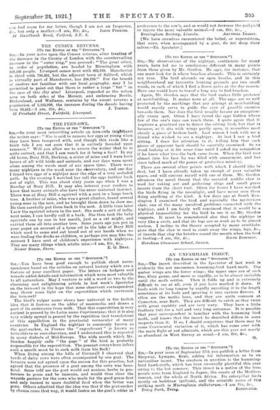ITO THE EDITOR or THE " SPECTATOR. "I
Sia,—My observations of the nightjar, continuous for many years, have led me to conclusions different in many points from those given by Mr. Gordon. He says, for instance, that one must look for it where bracken abounds. This is certainly not true. The bird abounds on open heaths, and in this' neighbourhood my favourite hunting grounds are two small woods, in each of which I find a dozen pairs at the due season.' Here one would have to travel a long way to find bracken.
Again, Mr. Gordon says that the bird makes little pretence at nest-building. It makes none at all. The eggs are so well protected by the markings that any attempt at nest-building would merely servo to guide the eyes of possible enemies towards them. Nor does the bird usually favour an exception-. ally sunny spot. Often I have found the eggs hidden where few of the sun's rays can reach them. I quite agree that it requires a practised eye to detect the sitting bird, but that is because, as it site with wings partly open, it resembles most closely a piece of broken bark. Last season I took with me a' friend who wished to see a nightjar. At last I saw a bird sitting. I drew his attention to it, telling him that such pieces of apparent bark should be carefully examined. So we stood looking at it for some time until I asked my companion' if he knew what tree the bark came from. When the bird rose almost into his face ho was filled with amazement, and has since talked much of the power of protective mimicry.
There are several other points with which I should like tot deal, but I have already taken up enough of your valuable space, and will content myself with one of them. Mr. Gordon advances the novel theory that the serrated middle claw is used for raking out and gathering slugs and small grass insects from the short turf. Often for hours I have watched the birds flying in the moonlight, and have never seen them doing anything of the kind. A few days ago at South Ken- sington I examined the bird and especially the mysterious claw, one of the many unsolved problems connected with the nightjar, and I am fairly well convinced that it would be a physical impossibility for the bird to use it as Mr. Gordon suggests. It must be remembered also that the nightjar is very like a swift, and that its legs are so weak as to be almost useless. I incline to the theory accepted by many ornitholo- gists that the claw is used to comb away the wings, legs, &c., of insects that clog the bristles round the mouth when the bird is feeding.—I am, Sir, &c., RALPH ROBINSON. Horsham Grammar School, Sussex.


































 Previous page
Previous page